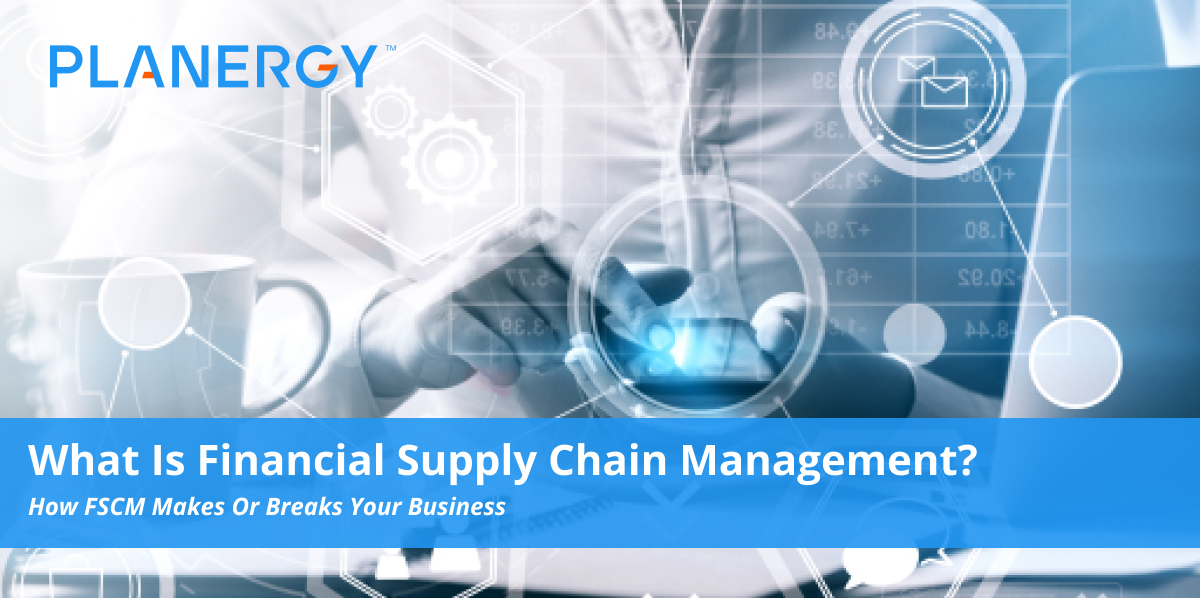Financial supply chain management (FSCM) is the practice of looking at all your financial processes at the holistic level, rather than viewing them as individual processes.
It’s the end-to-end process that involves the procure-to-pay cycle, working capital management, and the order-to-cash cycle business processes.
Within it, this covers everything that’s part of ordering, invoicing, reconciliation, and payment.
The overall goal of financial supply chain management is to achieve and maintain visibility into all of these processes so that your supply chain can be as efficient as possible and capitalize on cost savings throughout the chain.
In the past, cash management was considered separate from purchasing and physical supply chain management. As technology has improved, purchasing professionals are embracing the entire process and treasury managers appreciate the connection between supplier relationship management and cash management.
FSCM carries the flow of money and financial information opposite the flow of goods and services.
Processes in the Financial Supply Chain
The FSCM is made up of three components: the procure-to-pay cycle, working capital management, and the order-to-cash cycle.
In addition to the focus on the financial information flow in these processes, it also considers the needs and behaviors of departments (and their employees) in the organization.
For instance, sales trends may be influenced by offering employee bonuses, changes in department heads, unexpected resignations, and scheduling delays.
Procure-to-Pay Cycle
The P2P cycle is the trade cycle as seen from the point of view of the company that’s buying materials, goods, or services.
During this process, the company chooses, receives, and pays for the items required to produce the goods or services they supply to their customers.
Working Capital Management
This area of finance is tricky for businesses, but proper management is essential to keeping operations running smoothly and ensuring everyone has what they need to get their respective jobs done completely and on time.
Every business must have a certain amount of working capital they use to order goods and services to continue operations as usual while they wait for their outstanding invoices to be paid.
It’s a delicate balance, because if there isn’t enough product in inventory to sell to customers, then you must spend more money to keep manufacturing product to sell.
But, if there are too many unpaid invoices from customers, you may not have the capital available to continue ordering what you need to keep up the necessary supply.
Working capital management is the accounting strategy that a business uses to balance current assets and liabilities to ensure the company remains financially efficient, always maintaining the necessary cash flow to meet short-term operating costs such as paying utility bills and employees, as well as any short-term debt obligations.
When working capital management is handled well, it minimizes the amount of time required to convert assets and liabilities to cash, while also helping to improve earnings, and most importantly, profitability.
Working capital management involves balancing inventory management with both accounts receivable and accounts payable.
You must not have too much capital tied up in unused inventory, but at the same time, you must ensure you have enough inventory on hand to be able to fill all your customer orders and keep product flow steady.
It’s important to not have major expenses going out around a time when more cash isn’t coming into the business.
To improve working capital, companies can spend less money on goods and services by negotiating discounts and better payment terms with their suppliers.
For instance, ordering 20% more product to produce significant savings, or paying the invoice in full within 30 days provides a discount on the total invoice.
Companies can also adjust their payment terms with their customers, to ensure that all their money comes in in a timely manner, by offering early payment discounts and/or charging late payment fees.
Order-to-Cash Cycle
The O2C cycle is the same trade cycle as P2P, except it is in seen from the point of view of the company that’s supplying the materials, goods, or services.
It starts when the supplier provides the quote for their customer and ends once the payment has been received and the invoice is reconciled.
From a finance perspective, the key area in this cycle is account receivable.
After the invoice has been issued, the finance department must collect payments in the most efficient and timely manner possible.
How FSCM Software Helps Companies Improve
Companies that are making use of ERP can use financial supply chain management solutions to keep an eye on financial flows and other relevant information in real-time.
These automated systems make it easier to spot problems in both the P2P and O2C cycles.
With data readily accessible, the finance department can see how many purchase orders are in the system that will require invoice payment within a certain window of time.
They can also keep an eye on the financial transactions as a whole to help identify potential opportunities to lower cost.
Automated systems allow for more efficient invoice processing and reduce the length of time accounts receivable has to spend chasing down customer payments.
For the greatest chance of effective and efficient FSCM, it’s critical to establish standards for consistency in both your P2P and O2C cycles, no matter the current size of your company.
As you grow, having standard procedures in place will make everything easier to manage.
Using software saves many man-hours wasted on paperwork, reduces error potential, and keeps everyone accountable.
Integrating your systems can help reduce the length of your O2C cycle, which could make a tremendous difference in your available working capital.
The faster you can acquire the goods and services you need for production and reconcile those invoices, the better deals you can negotiate with your suppliers.
The faster you can get your products and invoices in the hands of your customer, the more sales you can make.




